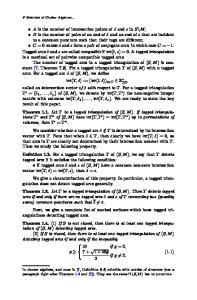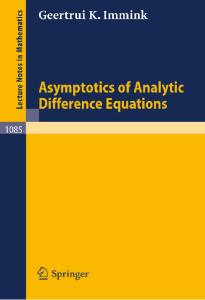Difference equations arising from cluster algebras
- PDF / 822,636 Bytes
- 57 Pages / 439.37 x 666.142 pts Page_size
- 75 Downloads / 422 Views
Difference equations arising from cluster algebras Yuma Mizuno1 Received: 23 February 2020 / Accepted: 28 August 2020 © Springer Science+Business Media, LLC, part of Springer Nature 2020
Abstract We characterize Y/T-system-type difference equations arising from cluster algebras by triples of matrices, which we call T-data, that have a certain symplectic property. We show that all mutation loops are essentially obtained from T-data, which generalizes the general solution for period 1 quivers given by Fordy and Marsh. We also show that any T-datum associated with a periodic Y/T-system has the simultaneous positivity. As an application, we propose a version of Nahm’s conjecture from a viewpoint of cluster algebras. We conjecture that given a periodic T/Y-system of a certain type, we have a family of hypergeometric q-series that are also modular functions. Keywords Cluster algebras · T-systems · Y-systems · Nahm’s conjecture Mathematics Subject Classification 13F60
1 Introduction Cluster algebras were introduced by Fomin and Zelevinsky in the seminal paper [11]. A cluster algebra is a commutative ring equipped with a combinatorial structure called a cluster pattern. A cluster pattern is a graph whose vertices are clusters, which are tuples of cluster variables, and edges are exchange relations. Such combinatorial structures have been found in many areas of mathematics, and thus the theory of cluster algebra has many applications. One of the main applications of the theory of cluster algebras is the study of discrete dynamical systems. In their fourth paper on cluster algebras [14], Fomin and Zelevinsky introduced bipartite belts, which are discrete dynamical systems associated with bipartite symmetrizable generalized Cartan matrices. They proved that the bipartite belt associated with a generalized Cartan matrix A is periodic if and only if
B 1
Yuma Mizuno [email protected] Department of Mathematical and Computing Science, Tokyo Institute of Technology, 2-12-1 Ookayama, Meguro-ku, Tokyo 152-8550, Japan
123
Journal of Algebraic Combinatorics
A is of finite type, that is, there exists a vector v > 0 such that Av > 0. Thus, periodic bipartite belts are classified by the Cartan–Killing classification. This result generalizes and refines the periodicity of Zamolodchikov’s Y-systems, which was conjectured by Zamolodchikov [51] in the study of thermodynamic Bethe ansatz, and proved by Fomin and Zelevinsky in [13] prior to their fourth paper [14]. They also proved that there is a bijection between the set of terms appear in a bipartite belt associated with a finite-type Cartan matrix A and the set of almost positive roots in the root system associated with A. A key fact in the proof of these results is that terms in a bipartite belt are realized as cluster variables in some cluster algebra, and recurrence relations of this bipartite belt are realized as exchange relations in the same cluster algebra. Bipartite belts are very special cases of discrete dynamical systems called Y-systems and T-systems in cluster
Data Loading...











